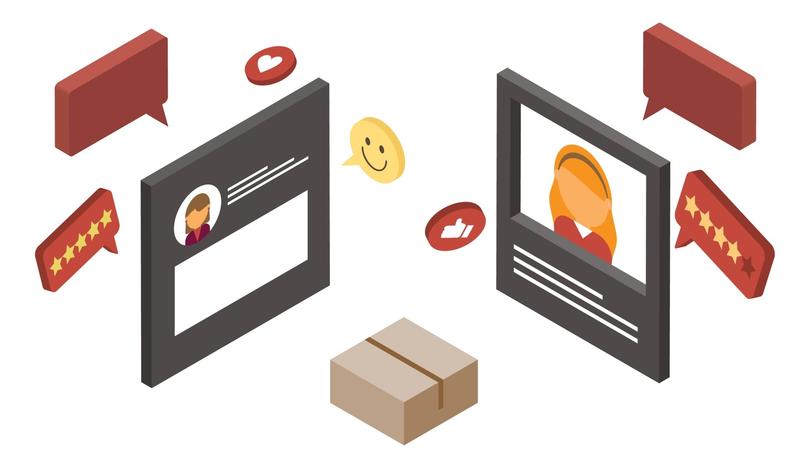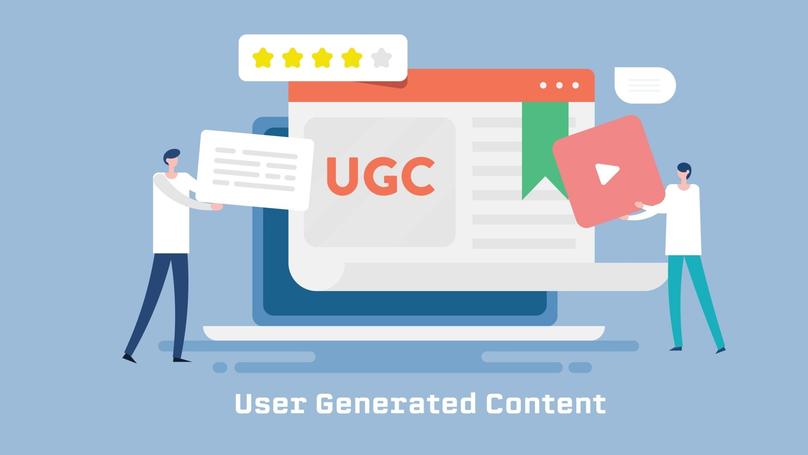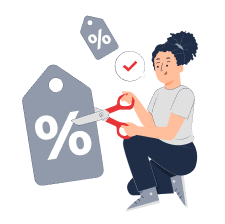User-generated content

What is UGC?
UGC, short for User-Generated Content, refers to content created by regular users rather than professional marketers, copywriters, or journalists. Essentially, UGC includes reviews, comments, photos, videos, text reviews, and articles that capture individuals' experiences with a particular product or interactions with a brand and its representatives. The key aspect is that this content reflects the genuine experiences of real people.
These publications help build customer trust in a brand and promote it for free. Additionally, this is a crucial component of the brand community, as UGC provides a chance for ordinary users to voice their opinions, share their experiences, and connect with the brand.
What types of UGC are there?
Despite the simple definition of UGC - content created by regular users - it can take various forms. One of the most common formats is reviews, which can be posted on the brand's website, the marketplace where the product was purchased, social media, specialised forums, and review sites. Video reviews of purchased goods are equally popular, particularly the Unpacking format, where users showcase their purchases, unbox products, and share their first impressions while trying them out.
Here are some additional UGC formats that stand out:
-
Comments: these will boost user engagement and help create and sustain a positive company image;
-
Photographs: which demonstrate to potential customers how others successfully use a particular product;
-
Articles: where users share practical experiences and advice on using purchased products;
-
Contests, challenges, and flash mobs: for example, when a brand launches a hashtag and invites customers to participate in a particular promotion, it increases their emotional involvement and social media reach. In essence, user-generated content enables customers to share their experiences with a purchased product and interact with sellers and the brand, making it easier for potential audiences to make buying decisions.
Benefits of UGC
However, boosting sales and average transaction value is just one benefit of using UGC. This type of content also addresses several key business tasks. For instance, user publications allow you to:
-
Gain customer trust and maintain a business reputation. According to statistics, the general public trusts other consumers more than direct advertising from a brand, making user-generated content far more effective at attracting new customers.
-
Increase conversion and increase other SEO indicators. For instance, the more genuine user comments, reviews, and online mentions a brand receives, the greater the likelihood that potential customers will visit the official website, become interested, and ultimately buy something.
-
Form a community. Users who create their own content represent the brand's most loyal audience. They actively share discoveries and life hacks, discuss and debate various products, and promote the company's products for free.
-
Obtain feedback and help improve the product. Genuine feedback from users is regarded as the most effective way to identify existing issues and address any shortcomings.
-
Discover new ideas. Questions, reviews, photos, and videos from users can inspire a brand to develop a new creative idea for an advertising campaign or rebranding effort.
-
Sell more. Generally, buyers are more swayed by reviews, comments, and ratings from other users, which ultimately influence their buying decisions more than promotional mailings and media advertising.
Who can create user content?

Broadly speaking, users can be categorised into four groups. These include:
- Creators: these are professional content creators who capture high-quality photos, produce videos, and write articles about products from various brands, doing so in a very organic and natural manner. Their content typically sells, entertains, and engages other users.
- Current customers: these are everyday individuals who voluntarily share their opinions about a brand or specific product. The most prominent and clear example is reviews on marketplaces or the brand's social media platforms.
- Regular customers or loyal customers: these are the most loyal customers who gladly create unique content, even without any incentives from the brand. They genuinely showcase the advantages of the brand's products with sincere enthusiasm.
- Employees or brand representatives: typically, this content includes a detailed description of the product's unique selling proposition (USP), its value, and the necessity of purchasing it.
Anyone can create UGC, including you! By leaving reviews, comments, or overviews, you can earn bonuses, discounts, and even free products. All you need to do is share your opinion about a specific product, participate in competitions or promotions, engage more frequently with other users by responding to their comments, and repost content from the brand's official social media, etc. Be more active, and as you become a regular customer, unique offers will come your way.
User-generated content vs. influencer marketing
Both user-generated content and influencer marketing contribute to shaping a brand's image, enhancing recognition, adding variety to social media channels, and leaving a digital footprint. However, to achieve these goals and deliver tangible results, UGC and influencer marketing employ different methods and approaches.
First, let's clarify that influencer marketing is a promotional strategy that involves collaborating with popular bloggers, celebrities, and experts. An influencer is an opinion leader capable of influencing a wide audience. Therefore, the definition itself highlights the differences between influencer marketing and user-generated content. Let's examine these differences more closely:
|
Influencer Marketing |
UGC |
|
The primary aim of an influencer is to sway their audience into purchasing a specific product. |
The goal of creating user-generated content is to share experiences and convey personal opinions. |
|
Influencers typically produce content professionally and maintain ongoing collaborations with brands. This approach promotes not only the brands' products but also the influencers' personal brand. |
Regular users create this content, which does not include direct advertising. These are genuine and honest reviews from consumers, shared solely to express their opinions and impressions of the product. |
|
In one way or another, collaboration with an influencer involves some payment. |
Consumers engage in this voluntarily and do not anticipate any compensation from the brand for their initiative. |
|
Advertising ordered from an influencer targets a specific segment of the audience that genuinely trusts this person and shares their interests, values, and views. |
Aimed at a broader and more diverse audience since anyone can become a UGC content creator. |
|
Influencers frequently play a pivotal role in marketing strategies designed to attract new audiences, expand reach, and boost sales. Their impact stems from the strong and trusting relationships they maintain with their followers. |
UGC creators mainly provide the brand with authentic, high-converting reviews, which enhance the trust level among potential consumers. |
Therefore, UGC is a more accessible and flexible strategy for creating engaging and useful content. However, user-generated content is the least controlled by the brand, as it can include not only positive comments and gratitude but also negative reviews, low ratings, and dissatisfaction. Demonstrating real consumer experiences significantly influences the behaviour of potential customers.
Although influencer marketing is more costly for companies, it can deliver guaranteed results and enhance brand authority. For it to be effective, it's vital to choose the right influencer whose values and worldview align closely with those of the majority of the brand's target audience.
Nowadays, as high-quality promotional content becomes increasingly valuable and personalities' influence on user choices grows, it is important to focus on both influencer marketing and user-generated content. Encouraging the creation of comments, reviews, brand-related stories, and other types of content is essential.
Best platforms for creating user-generated content

In addition to social networks, such as Instagram, X, and TikTok, you can create UGC content on a variety of platforms. Here are some of the most common of them:
-
Yelp
This platform specialises in helping users find a wide range of places, from cafes and restaurants to beauty salons, hardware stores, and advertising agencies. Users can leave detailed reviews, post photos and video reviews, create ratings, and discuss various establishments, highlighting their pros and cons. Currently, Yelp is active in over 100 countries and boasts nearly 150 million monthly users.
-
TripAdvisor
TripAdvisor is one of the largest resources for travellers. Users can leave reviews and rate travel agencies, hotels, restaurants, and attractions across various countries. The platform allows you to share photos, videos, detailed descriptions, life hacks, and personal experiences. Today, TripAdvisor serves as a vast database filled with essential travel information.
-
Trustpilot
This platform allows users to post reviews for a wide range of companies offering various services. The process is straightforward-create a free account, leave a review, share life hacks, discuss your experiences, and offer advice. Interestingly, companies can also create accounts to respond to consumer comments and engage in dialogue with their clients.
-
Reddit
Reddit is a website that incorporates elements of social networks and forums. Registered users can post links to their favourite companies, establishments, or agencies and share useful information in response to other users' queries. Reddit is divided into various sections known as subreddits, each dedicated to a specific topic or interest. Here, you can ask virtually any question and receive comprehensive answers quickly. Additionally, the platform allows you to organise events and user meetups, fostering real connections within its vast community.
Using these platforms to create user-generated content provides opportunities to express opinions and helps build close-knit communities around various companies. Consequently, UGC plays a crucial role in marketing strategies by fostering interaction between brands and consumers.
How to use UGC content correctly
To encourage consumers to share positive experiences, write favourable comments, and recommend your brand to others, it's vital to incentivise audience engagement. Here are the most common and effective ways to motivate customers:
- Offer gifts
Encourage your customers to write comments, post photos, and review your products by offering symbolic gifts, such as brand merchandise or a new product line.
- Offer discounts, points, and other bonuses for reviews
This is especially relevant for companies that have recently entered the market and are still building audience trust. For instance, you can prepare an email newsletter asking customers to leave their details after purchasing and then write a review using a provided link. Additionally, this practice is quite popular on marketplaces, where customers receive a request to leave a review in exchange for a coupon, promo code, or bonus upon opening their package.
- Consistently reply to comments and questions
It's crucial to support customers' initiatives and interest in your products. Always thank users for their comments and respond even to negative reviews, addressing any issues to maintain a strong business reputation. Additionally, you can create a dedicated section on the company's official website for questions and answers, where both customers and brand representatives can engage in discussions. This approach not only generates unique UGC content but also provides an excellent extra resource for assisting consumers.
- Organise sweepstakes and contests
For instance, you can invite customers to join a contest by submitting the best photo of your product, the most creative comment, or a similar challenge. Offer prizes such as products from the new line, branded merchandise, or discount coupons.
- Propose collaboration
You can offer your most loyal customers commercial collaboration, compensating them for each video review or article they publish about their experience with your product.
- Organise mass events
You can engage your audience not only through online activities but also via various events. This could include the launch of a new product line, educational webinars, master classes, fairs, and more. These events provide opportunities for everyone to learn about their favourite brand, create unique user-generated content, share their impressions on social media, and value the company for new opportunities.
- Create a brand hashtag
A company should have its own hashtag-a catchy, concise, and memorable phrase or even a single word. Hashtags can be featured directly on products or packaging and promoted through bloggers as well as regular users.
Best user-generated content examples

User-generated content has become an essential component of brand promotion, actively utilised by a diverse range of companies, from local businesses to global corporations. For instance, Coca-Cola's Share A Coke campaign replaced the traditional logo on bottles with popular names. On the ShareACoke.com website, you could purchase a bottle with a personalised inscription and send the drink as a gift in a beautiful package to a friend or loved one. Additionally, the campaign included various prize draws, such as a free trip to an amusement park. Naturally, all Share A Coke participants shared their experiences and talked about the prizes they won on social media, the company's official website, and a dedicated page created for the campaign.
The American action camera company GoPro frequently leverages UGC. They invite customers to share extreme videos and photos captured with their cameras, showcasing the product's capabilities. This highlights their product in action, demonstrates its advantages, and motivates potential customers to buy it.
Similarly, Airbnb, the online platform for short-term rentals, collects user stories about their travels. They gladly publish photos and videos from different countries, inspiring others to travel around the world and, naturally, use Airbnb during their trips.
The Starbucks coffee chain actively supports user-generated content. A few years ago, it launched the White Cup Contest, where participants were asked to draw on a cup and post photos on their social media with the hashtag #WhiteCupContest. Starbucks then selected a winner and printed their drawing on reusable cups.
Similarly, the Chipotle restaurant chain's hashtag #ChipotleSponsorMe gained immense popularity. The brand's marketers invited customers to create videos explaining why they should participate in the promotion to win a free year of Chipotle visits. As a result, the hashtag garnered over 2.3 billion views, generating a huge amount of essentially free advertising on social media.
Another notable example is the Lego Group's annual Build to Give campaign. The brand invites regular customers to build a LEGO star model of any size and colour, photograph it, and share it on social media or the LEGO Life app using the hashtag #BuildToGive. This initiative is not only an advertising campaign but also a charitable event, allowing children with mental and physical disabilities to experience the joy of play.
The American luggage and travel accessories brand Away consistently shares authentic user reviews of its products on its official Facebook page. Notably, the platform features both positive and negative comments. Crucially, Away addresses every question, opinion, or complaint, striving to make interactions with the brand as comfortable and convenient as possible.
By encouraging users to generate UGC, companies can boost audience engagement, drive sales, and create unique content and products without incurring additional costs.
Conclusion
Today, user-generated content is essential for any successful and profitable brand. Utilise it to boost sales, increase your audience, expand the number of loyal customers, enhance brand recognition, and enter new markets. For young brands, the initial focus should be on encouraging reviews and comments on social media. For further promotion using UGC, regularly host contests, giveaways, and promotions, create creative challenges for your customers, develop hashtags, and maintain strong relationships with your audience. This is the most cost-effective way to build a positive image and stay connected with your consumers.























